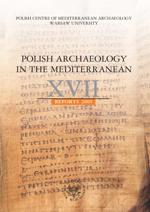LATE ROMAN/EARLY BYZANTINE GLASS FROM THE AUDITORIA ON KOM EL-DIKKA IN ALEXANDRIA
LATE ROMAN/EARLY BYZANTINE GLASS FROM THE AUDITORIA ON KOM EL-DIKKA IN ALEXANDRIA
Author(s): Renata KucharczykSubject(s): Archaeology
Published by: Wydawnictwa Uniwersytetu Warszawskiego
Keywords: Egypt; Alexandria; auditoria; Late Roman period; Early Byzantine period; glass vessels; windowpanes; glass production
Summary/Abstract: This report continues the presentation of glass from the excavation of a complex of lecture halls uncovered on Kom el-Dikka. The material is dated to the Late Roman/Early Byzantine period (4th–7th centuries AD). Apart from lamp and windowpane fragments, none of the other objects can be related directly to the assumed function of the auditoria. Ordinary household containers are common in the assemblage. They are represented by different fragments, chiefly bases and necks with fire-rounded rims. Funnel-neck bottles are the most characteristic among them. Also represented are other glass vessels of daily use, including open forms. Considerable amounts of shards belong to three categories of lamps: conical vessels with cracked-off rims, tumbler-shaped lamps and stemmed lamps. All the recorded fragments are typical of the period, the type and function being the same regardless of whether the glass is from the Alexandrian area specifically or from elsewhere in Egypt. All the vessels were free blown. Most of them were unadorned. The discovery of two well-preserved circular structures made of red bricks, obviously furnaces, under the floor of auditorium G came as a surprise. Unfortunately there is no surviving evidence of the superstructures.
Journal: Polish Archaeology in the Mediterranean
- Issue Year: 2007
- Issue No: XVII
- Page Range: 45-53
- Page Count: 9
- Language: English

